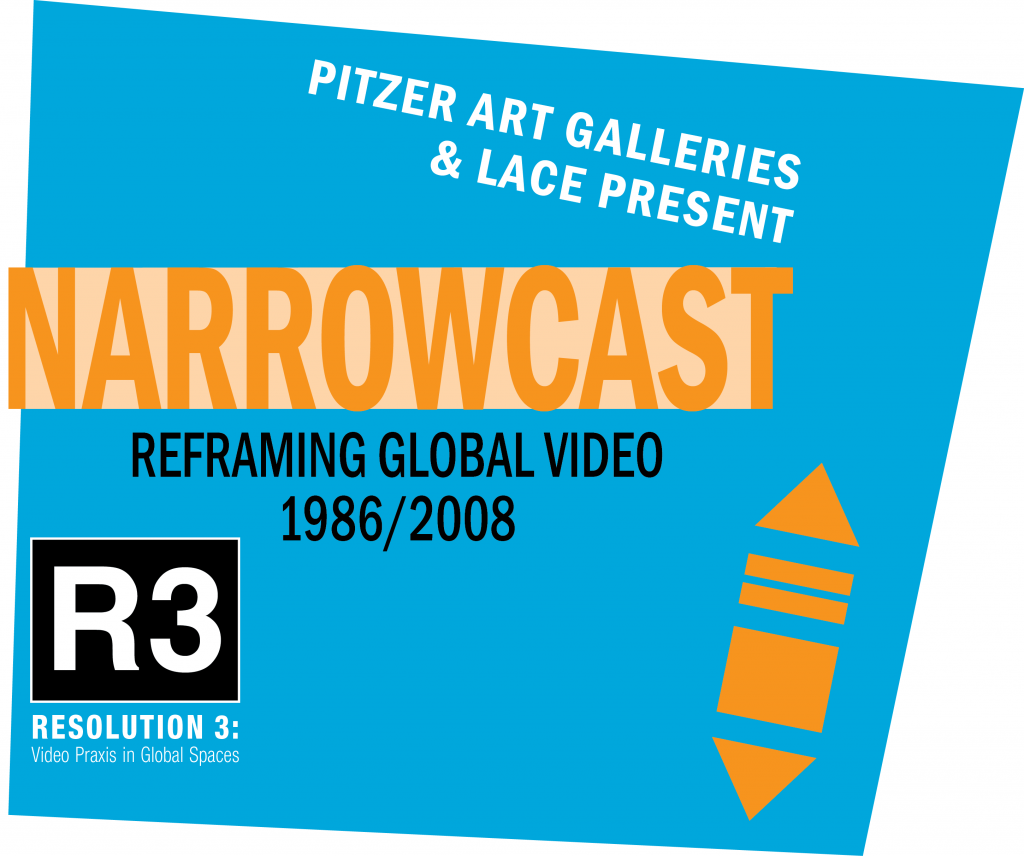
Narrowcast: Reframing Global Video 1986/2008
September 25 – November 23, 2008
Pitzer College Art Galleries
Lynn Blumenthal, Juan Downey, Antonio Muntadas, Marshall Reese, Michael Smith, Bill Viola, Natalie Bookchin, Mark Boulos, Regina Jose Galindo, Pablo Pijnappel, Artur Zmijewski
Curated by Ciara Ennis and Ming-Yuen S. Ma as part of Resolution 3: Video Praxis in Global Spaces
Pitzer Art Galleries & LACE present Narrowcast: Reframing Global Video 1986/2008 curated by Pitzer Art Galleries Director/Curator Ciara Ennis and Associate Professor of Media Studies Ming-Yuen S. Ma. The exhibition is part of Resolution 3, a collaboration between Pitzer College’s Media Studies program, Pitzer Art Galleries and LACE on the occasion of LACE’s thirtieth anniversary.
Narrowcast re-presents selected works from LACE’s seminal 1986 video exhibition Resolution: A Critique of Video Art and pairs them in compelling and unexpected ways with contemporary works, thus framing the medium’s brief history both formally and thematically. Resolution was one of the first exhibitions in the United States to embrace video as a serious art form and to discuss it in critical terms. Revisiting Resolution in relation to a number of exceptional contemporary video works demonstrates the influence that video art has had on artistic practice over the past two decades and testifies to the pivotal role and ubiquitous presence that the medium has in the contemporary global art world.
The ten selected artists in Narrowcast—five historical: Lyn Blumenthal, Juan Downey, Antonio Muntadas in collaboration with Marshall Reese, Michael Smith, Bill Viola and five contemporary: Natalie Bookchin, Mark Boulos, Regina José Galindo, Pablo Pijnappel, Artur Zmijewski—re-present Resolution in a way that emphasizes resonance and precedence rather than a comprehensive survey. And while the selected works, one from each artist, do not fit into neat categories, Curators Ennis and Ma have found historically significant connections that highlight the multi-layered and fragmented narratives inherent in both the archival and contemporary works.
Separated into five loose categories—embroidered narratives, autobiographical confessionals, restaging histories, documentary and reportage, trance and ritual—the works in Narrowcast reframe content as well as formal strategies that are as relevant in 1986 as it is now, thereby reflecting the range and inventiveness of the non-traditional narrative structures central to these artist’s works.
About Pitzer Art Galleries
Pitzer Art Galleries exists to provide visually arresting and memorable exhibitions that promote the value and understanding of contemporary art within a local, national and international context. The Galleries are comprised of two sites, the Nichols Gallery—committed to solo and group exhibitions by national and international artists both emerging and established— and the Lenzner Family Art Gallery—a space for risk and experimentation dedicated to emerging artists working in all media. Through curatorial creativity and visionary programming Pitzer Art Galleries seeks to provide context, support and a critical framework for artists and curators working today and by doing so inspire meaningful dialogue that fascinates, inspires and invigorates.
About Los Angeles Contemporary Exhibitions (LACE)
Since 1978, LACE has maintained an unwavering commitment to innovation in the visual arts. LACE presents and supports a variety of projects each season, including exhibitions, performances, publications, discussions, screenings, and public art works. For three decades and counting, LACE has presented the work of over 5,000 artists in over 3,000 programs and events LACE’s programming is either free or low-cost, making it accessible to all audiences. For more information please visit www.welcometolace.org. LACE Media contact: Carol Stakenas: (323) 957-1777 ext. 15, [email protected].
Narrowcast: Reframing Global Video 1986/2008 and Resolution 3 are funded through the generous support from The Andy Warhol Foundation for the Visual Arts, the City of Los Angeles, Department of Cultural Affairs, The Getty Foundation, Intercollegiate Media Studies at The Claremont Colleges, The James Irvine Foundation, Jockey Hollow Foundation, Los Angeles County Arts Commission, Morris Family Foundation, the Pasadena Art Alliance, Pitzer College (Pitzer Art Galleries, Frederick J. Salathé Fund and Pitzer Summer Research Assistantship), Scripps Humanities Institute, Stone Brewing Co., and the members of LACE.
RAPT
The legendary storyteller in “One Thousand and One Nights,” Scheherazade, cleverly evaded death with a tale so alluring that her persecutor, eager for the next installment, delayed her execution. Scheherazade’s talent for crafting suspenseful tales kept her listener in rapt submission and delivered him from despotism to enlightenment. For centuries, fables, myths, legends, and oral histories have employed a variety of strategies to educate, propagandize, seduce, enthrall, and entertain. Similarly video art, during its relatively short lifespan, has made its identity clearest by expanding, exploding, and subverting the familiar notions of sound and imagery. Like Scheherazade’s tales the works in the Narrowcast: Reframing Global Video 1986/2008 are inventive, varied, and compelling.
With the benefit of more than twenty years hindsight Narrowcast revisits five pivotal works from LACE‘s historic 1986 video exhibition, Resolution: A Critique of Video Art—one of the first exhibitions to fully embrace video as a mature art form—and gauges that work in relation to five exceptional contemporary efforts. Narrowcast is by no means a survey but a speculative look into the future of video art by examining its past and present. Linked by the breadth of their descriptive spectra—embroidered narratives, autobiographical confessionals, restaged histories, documentary and reportage, trance and ritual—the works testify to the range of expository strategies both then and now.
Even though it predates the launch of MTV by just one year, Michael Smith’s prescient Secret Horror (1980) references and lampoons music-video, reality television and sitcoms. The absurdist narrative features Mike, an underwhelming slacker, losing his ability to distinguish between television and reality. While Secret Horror is by far the most linear work in the exhibition, its tale of confused identities has parallels to many of the contemporary works in Narrowcast. Contrary to Smith’s daft comedy, Walderedo (2006) by Pablo Pijnappel presents a melancholic work about his renowned psychoanalyst grandfather and depressed artist father. Suggestive of newsreels and home movies, Pijnappel’s transcontinental tale is comprised of archival, found, and recent footage of personal and cultural dislocation. Merging fact and fiction Pijnappel creates his family’s past, making his own identity ever more elusive.
The act of confession characterizes Lyn Blumenthal‘s Doublecross (1985) and Artur Zmijewski‘s Game of Tag (1999). The un-named protagonist in Doublecross is forced to confess and defend her sexual preferences and desires as the work takes aim at societal and cultural institutions that police and dictate definitions of sexual selfhood. In Game of Tag (1999) Zmijewski pulls at the scab of our collective guilt regarding Nazi genocide. In an abandoned Polish gas chamber a group of naked people shift from embarrassed immobility to feverish hysterical interaction as they play “tag.” Zmijewski’s work reminds us of what, given the right circumstances, we are all prepared to condone.
Antonio Muntadas with Marshall Reese and Regina José Galindo are all concerned with re-staging specific histories. In Political Advertisement I, 1952–1984 (1984) Muntadas and Reese trace the development of presidential campaign advertisements from the simple direct address of the Eisenhower years to the manipulative strategies of the Reagan era. In Muntadas and Reese‘s timely work, television is where campaigns are won, a position illustrated by a 2004 message paid for by the Swift Boat Veterans For Truth, which so defamed Democratic presidential nominee John Kerry that public opinion irrevocably shifted. In Quien Puede Borrar las Huellas (2003)— Who Can Remove the Traces—Guatemalan artist Galindo explores state-sanctioned violence. Who Can Remove the Traces follows Galindo to the National Palace in Guatemala City, former home to dictator Efrain Rios Montt. Her path is marked by bloody footprints in remembrance of the 70,000 indigenous Mayan people Montt is accused of butchering. Montt’s murderous history remains a lingering presence through Galindo‘s gory pilgrimage. Galindo, like Zmijewski, forces us to confront that from which we would prefer to look away.
Both Juan Downey‘s Shifters (1984) and Natalie Bookchin‘s trip (2008), comprised of newsreel footage of disparate subjects and locations across the globe, appear at first to have been the contrivance of a frenetic foreign correspondent. Downey‘s Shifters combines text, audio and imagery to examine, malign and lampoon various idioms of art theory until the words and pictures combine to create a video equivalent of Babel. Bookchin‘s trip is a seventy-country travelogue linking hundreds of movies posted on YouTube. Each clip—shot from a moving vehicle’s window—displays a different location but reveals the urgent issues of borders and immigration, war and poverty, gender and class. From impoverished prostitutes in Russia to the exploding vehicles of civilian contractors in Iraq, Bookchin leads us on a trip to remember.
The exhibition’s earliest work, Chott el-Djerid (1979)—A Portrait in Light and Heat—by Bill Viola is named for the largest salt pan in the Sahara, used as a location for fashion shoots and the movie Star Wars. Exploring the romantic mystery of the desert, Chott el-Djerid records the apparition of villages rising upon an inhospitable plain as its people come and go. A visual transubstantiation, this sad demystification allows the camera’s refraction to stand in for the lens of the human eye. Viola transforms the arid, elemental flat into a remembrance and a foreshadowing. Spiritual and material excess underscore Mark Boulos‘s two-channel video installation All that is Solid Melts into Air (2008). One screen portrays frenzied oil traders at the Chicago Stock Exchange with their chanting and ritualized gestures. On the other, Niger Delta rebels—made invincible by their war god Egbisu— prepare for battle against the Nigerian state allied with corporations plundering their oil. Through art, Viola and Boulos, like a pair of tent revivalists, trade in spiritual salvation.
The ten works in Narrowcast employ a variety of narrative and formal methods, some linear, others fragmented; a few are soundless and contemplative while some are aggressive and raucous; truth underpins a couple and others are pure fantasy. Yet, all make use of the visual and aural possibilities of video to cast their spell upon the audience, holding us captive with anticipation.
Ciara Ennis
Director/Curator
Pitzer Art Galleries
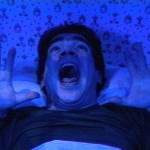
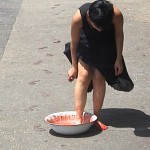
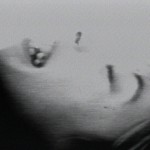
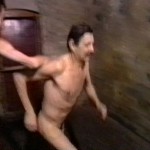

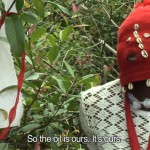
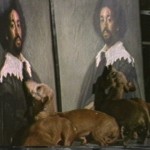


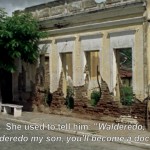
 WORLD IS WATCHING – MANIFESTO
WORLD IS WATCHING – MANIFESTO